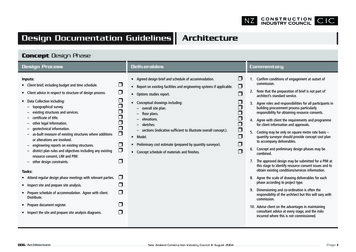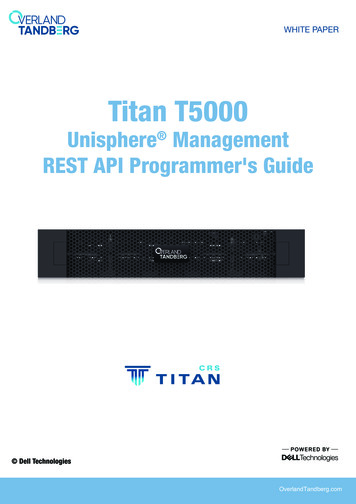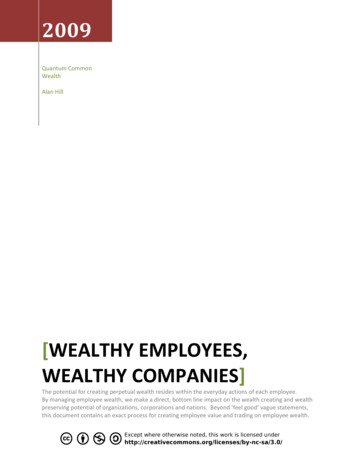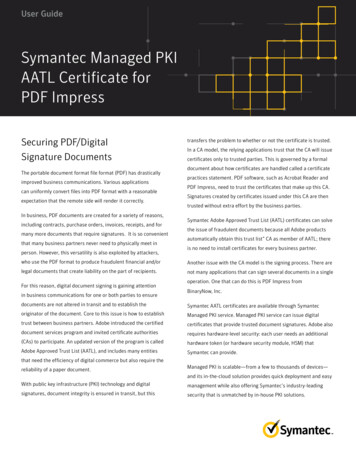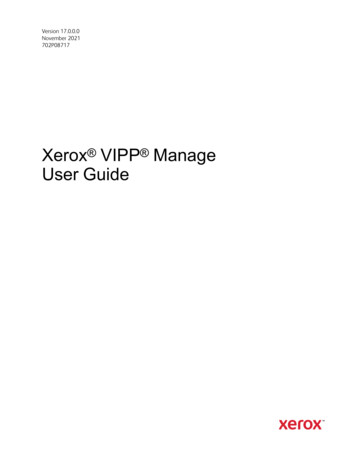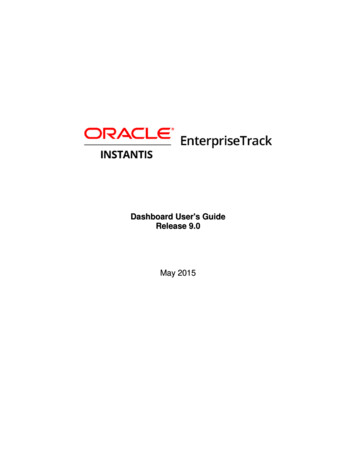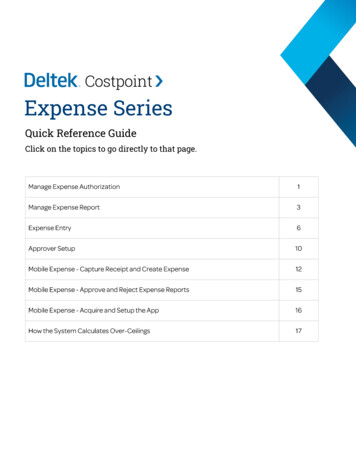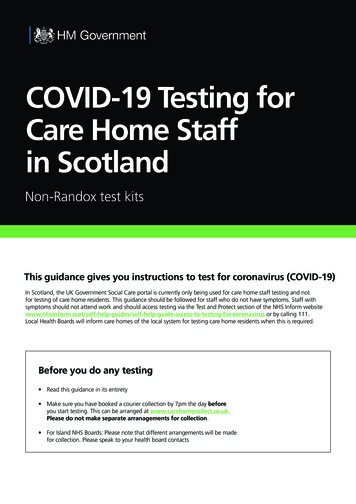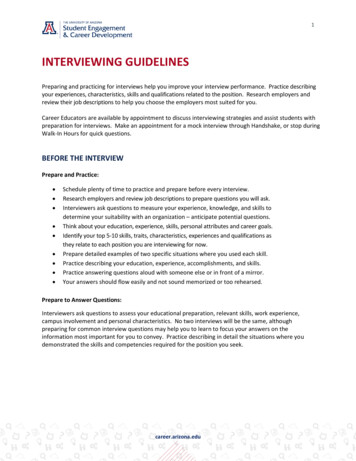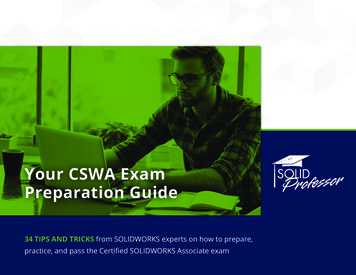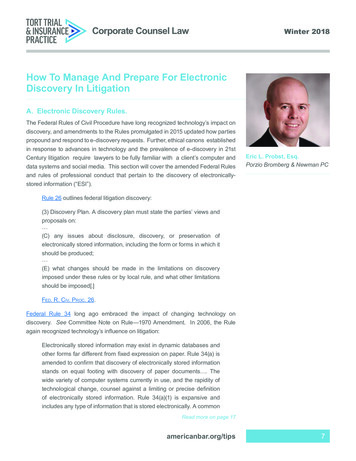
Transcription
Corporate Counsel LawWinter 2018How To Manage And Prepare For ElectronicDiscovery In LitigationA. Electronic Discovery Rules.The Federal Rules of Civil Procedure have long recognized technology’s impact ondiscovery, and amendments to the Rules promulgated in 2015 updated how partiespropound and respond to e-discovery requests. Further, ethical canons establishedin response to advances in technology and the prevalence of e-discovery in 21stCentury litigation require lawyers to be fully familiar with a client’s computer anddata systems and social media. This section will cover the amended Federal Rulesand rules of professional conduct that pertain to the discovery of electronicallystored information (“ESI”).Eric L. Probst, Esq.Porzio Bromberg & Newman PCRule 26 outlines federal litigation discovery:(3) Discovery Plan. A discovery plan must state the parties’ views andproposals on: (C) any issues about disclosure, discovery, or preservation ofelectronically stored information, including the form or forms in which itshould be produced; (E) what changes should be made in the limitations on discoveryimposed under these rules or by local rule, and what other limitationsshould be imposed[.]Fed. R. Civ. Proc. 26.Federal Rule 34 long ago embraced the impact of changing technology ondiscovery. See Committee Note on Rule—1970 Amendment. In 2006, the Ruleagain recognized technology’s influence on litigation:Electronically stored information may exist in dynamic databases andother forms far different from fixed expression on paper. Rule 34(a) isamended to confirm that discovery of electronically stored informationstands on equal footing with discovery of paper documents . Thewide variety of computer systems currently in use, and the rapidity oftechnological change, counsel against a limiting or precise definitionof electronically stored information. Rule 34(a)(1) is expansive andincludes any type of information that is stored electronically. A commonRead more on page 17americanbar.org/tips7
Corporate Counsel LawWinter 2018How to Manage. continued from page 7example often sought in discovery is electronic communications, suchas e-mail. The rule covers—either as documents or as electronicallystored information—information “stored in any medium,” to encompassfuture developments in computer technology.”See Committee Note on Rule—2006 Amendment.The 2015 amendments have again changed the Rule to address technology’s effecton discovery. Federal Rule of Civil Procedure 34 now reads:(a) In General. A party may serve on any other party a request withinthe scope of Rule 26(b):(1) to produce and permit the requesting party or its representativeto inspect, copy, test, or sample the following items in theresponding party’s possession, custody, or control:(A) any designated documents or electronically storedinformation—including writings, drawings, graphs, charts,photographs, sound recordings, images, and other data or datacompilations—stored in any medium from which information canbe obtained either directly or, if necessary, after translation by theresponding party into a reasonably usable form[.]Fed. R. Civ. Proc. 34(a)(1)(A). Counsel propounding e-discovery requests “mustdescribe with reasonable particularity each item or category of items to be inspected,”and “may specify the form or forms in which electronically stored information is tobe produced.” Id. at 34(b)(1)(A)(C). The producing party should object to anye-discovery requests that fail to satisfy the “reasonable particularity standard” ofparagraph (A). See id. at 34(b)(2)(C). The producing party can also object to theform in which ESI will be produced. Id. at 34(b)(2)(D). The Rule also addresseshow ESI will be produced:(E) Producing the Documents or Electronically Stored Information.Unless otherwise stipulated or ordered by the court, these proceduresapply to producing documents or electronically stored information:(i) A party must produce documents as they are kept in the usualcourse of business or must organize and label them to correspondto the categories in the request;(ii) If a request does not specify a form for producing electronicallystored information, a party must produce it in a form or forms inamericanbar.org/tips17
Corporate Counsel LawWinter 2018which it is ordinarily maintained or in a reasonably usable form orforms; and(iii) A party need not produce the same electronically storedinformation in more than one form.Id. at 34(b)(2)(E).The 2015 amendments attempt to remove discovery roadblocks objections to bestated with “specificity,” Fed. R. Civ. Proc. 34(b)(2)(B), and to specify whetherdocuments are being withheld based on the objection, Fed. R. Civ. Proc. 34(b)(2)(C). The amendments also advise counsel to identify the category of documentsbeing withheld from production based on an objection that the request is overbroad,and compels them to produce documents in response to the part of the individualdocument request that is not overbroad. See Committee Notes on Rule—2015Amendment.With the requirement that e-discovery requests be specifically tailored to the case,Rule 26(b)(1) imposes a proportionality requirement. Fed. R. Civ. Proc. 26(B)(1).(1) Scope in General. Unless otherwise limited by court order, the scopeof discovery is as follows: Parties may obtain discovery regarding anynon-privileged matter that is relevant to any party’s claim or defenseand proportional to the needs of the case, considering the importanceof the issues at stake in the action, the amount in controversy, theparties’ relative access to relevant information, the parties’ resources,the importance of the discovery in resolving the issues, and whetherthe burden or expense of the proposed discovery outweighs itslikely benefit. Information within this scope of discovery need not beadmissible in evidence to be discoverable.Proportionality levels the playing field in many cases and in others places the costof e-discovery more fairly on the party requesting the production of wide-rangingcategories of ESI.The most significant amendment is 37(e)—Sanctions. The 2015 amendmentreplaced section 37(e) in its entirety and applies exclusively to ESI. The 2006 versionof section 37(e) contained a “safe harbor” provision that protected a company fromsanctions if electronically-stored material was lost through “the routine, good-faithoperation of an electronic information system.” Fed. R. Civ. Proc. 37(e) (2006). 37(e)now reads:americanbar.org/tips18
Corporate Counsel LawWinter 2018(e) Failure to Preserve Electronically Stored Information. If electronicallystored information that should have been preserved in the anticipationor conduct of litigation is lost because a party failed to take reasonablesteps to preserve it, and it cannot be restored or replaced throughadditional discovery, the court:(1) upon finding prejudice to another party from loss of theinformation, may order measures no greater than necessary tocure the prejudice; or(2) only upon finding that the party acted with the intent to depriveanother party of the information’s use in the litigation may:(A) presume that the lost information was unfavorable to the party;(B) instruct the jury that it may or must presume the informationwas unfavorable to the party; or(C) dismiss the action or enter a default judgment.Fed. R. Civ. Proc. 37(e) (2016).Lawyers’ e-discovery obligations go beyond familiarity with the federal andlocal rules of civil procedure. The 2012 Amendments to the ABA Model Rulesof Professional Conduct reflect a lawyer’s duty to embrace and understandevolving technology. Rule 1.1, Competence, provides that, “[a] lawyer shall providecompetent representation to a client. Competent representation requires the legalknowledge, skill, thoroughness and preparation reasonably necessary for therepresentation.” ABA Model Rules of Professional Conduct, 1.1. Comment 8 tothe 2012 Amendments—Maintaining Competence—highlights a lawyer’s duty tounderstand technology: “To maintain the requisite knowledge and skill, a lawyershould keep abreast of changes in the law and its practice, including the benefitsand risks associated with relevant technology, engage in continuing study andeducation and comply with all continuing legal education requirements to which thelawyer is subject.” Id. at comment 8 (emphasis supplied).The impact of technology has reached the state level as state ethical guidelinesimpose similar obligations. See New York State Bar Association 2015 Guidelines(“A lawyer cannot be competent absent a working knowledge of the benefits andrisks associated with the use of social media.”). Further, New York requires lawyersto “keep abreast of the benefits and risks associated with technology the lawyeruses to provide services to clients or to store or transmit confidential information.”americanbar.org/tips19
Corporate Counsel LawWinter 2018Comment [8] to New York Rule of Professional Conduct 1.1. New York has alsowritten into the Rules these definitions:“Computer-accessed communication” means any communicationmade by or on behalf of a lawyer or law firm that is disseminatedthrough the use of a computer or related electronic device, including,but not limited to, web sites, weblogs, search engines, electronic mail,banner advertisements, pop-up and pop-under advertisements, chatrooms, list servers, instant messaging, or other internet presences, andany attachments or links related thereto.New York Rules of Professional Conduct, Rule 1.0(c). 23 states have adopted ABAComment 8 to Rule 1.1.1Ethical obligations have increased with the prevalence of data privacy issues. Rule1.6, Confidentiality of Information, now requires a lawyer to “make reasonable effortsto prevent the inadvertent or unauthorized disclosure of, or unauthorized access to,information relating to the representation of a client.” ABA Model Rules, 1.6(c). Alawyer’s ethical obligations to maintain the confidentiality of a client’s data is tied toRule 1.1. Comment 16 to 2012 Amendments to ABA Model Rules of ProfessionalConduct (“A lawyer must act competently to safeguard information relating to therepresentation of a client against unauthorized access by third parties and againstinadvertent or unauthorized disclosure by the lawyer or other persons who areparticipating in the representation of the client or who are subject to the lawyer’ssupervision.”).21st Century data privacy concerns are evident in the amendments to theModel Rules:A client may require the lawyer to implement special security measuresnot required by this Rule or may give informed consent to forgo securitymeasures that would otherwise be required by this Rule. Whether alawyer may be required to take additional steps to safeguard a client’sinformation in order to comply with other law, such as state and federallaws that govern data privacy or that impose notification requirementsupon the loss of, or unauthorized access to, electronic information, isbeyond the scope of these Rules.Comment 16 to 2012 Amendments to ABA Model Rules of Professional Conduct.americanbar.org/tips20
Corporate Counsel LawWinter 2018B. Litigation Methods.A critical component of a document retention policy is a “document hold” or “litigationhold” procedure.2 Once a company “reasonably anticipates” that a legal action orinvestigation is threatened, contemplated, or underway, the company must draftand disseminate a litigation hold letter to advise employees to preserve documentsand suspend document destruction policies. When a legal action is “reasonablyanticipated” is a difficult question for many companies. Does a trucking companyhave to issue a legal hold every time one of its drivers is involved in a fenderbender? Probably not. If the motor vehicle collision results in serious injury ordeath, a legal hold letter should be disseminated. Does a company have to issue alegal hold every time it terminates an employee? Probably not. When the employeeresigned and alleged mistreatment and discrimination, probably. A legal procedureor investigation can be reasonably anticipated when a corporation receives a noticeof claim, an EEOC Notice of Charge of Discrimination, a complaint, a notice of thefiling of an administrative proceeding, a demand letter from a lawyer or some otherwritten or verbal communication that indicates that a suit will or has been filed.The nature of the proceeding will dictate the documents to be preserved, but thecompany should err on the inclusive side.Several key elements apply to all litigation hold letters to ensure that employeespreserve and do not destroy documents. The letter should be drafted anddisseminated immediately after the corporation determines a triggering event hasoccurred. At the initial phase of the proceeding, the corporation should identifyrecords custodians and advise them of the claim and the categories of documentsthat must be preserved. Immediacy is crucial because ESI, more so than paperdocuments, is often destroyed daily as part of automated document destructionpolicies and during the recycling of backup tapes. A company can face manysanctions—from an adverse inference to the striking of a pleading—if documentsare destroyed, even inadvertently. Further, companies may compound the problemcreated when they fail to distribute a letter at the onset of the proceeding by failing toissue one later in the litigation; even a delinquent litigation hold letter will assist thecompany in meeting its document preservation and collection obligations.3The company need not send a global litigation hold letter. Instead, employees whopossess potentially relevant information and documents must receive it. Recordscustodians in Human Resources, Research and Development, Operations,Marketing, and Information Technology, will also need to receive litigation holdletters to the extent appropriate.americanbar.org/tips21
Corporate Counsel LawWinter 2018The letter’s scope, tone, and author are important. The letter must explain that theduty to preserve records is important to the company’s litigation position. It shouldalso identify the parties, the relevant dates, where the action is pending, and shouldconvey the serious nature and facts – preferably without too much legalese. Theimport of the letter is bolstered if the General Counsel signs the letter and copies theChief Executive Officer.The letter should expansively define the term “document” and the duties to preserveand not destroy must be explained. The document custodian must be told not todestroy documents, either under the document retention policy or otherwise, evenif they believe the documents may hurt the company and they should be remindedof that periodically until the matter is concluded. They should also be told thatthe company could be hurt just as much (if not more) by obstruction-of-justice andspoliation-of-evidence charges arising out of the destruction of documents than itmight be by preserving documents that may hurt the company.Finally, the letter should instruct that the duty to preserve and collect is ongoing anddocument destruction policies should be suspended until further notice.4 Attorneysupervision of document collection, especially ESI collection, is imperative becauseemployee-only searches more often destroy responsive documents than preservethem.5 Management, with the assistance of IT personnel, should periodically followup with the letter’s recipients to ensure compliance with the employees’ preservationduties and to answer any questions that may arise.C. Practical Information System Policies and Practices.A corporation’s information system policies and practices protect and securea company’s data, instruct employees on the proper use of technology in theworkplace, and provide a competitive advantage in the marketplace. Informationtechnology (“IT”) departments develop the policies with the human resources,operations and legal departments. Like technology, information system policies arenot static, and changes to technology require IT departments to review and revisethe policies periodically to meet the business’s needs.Companies typically tailor information policies to their business but the followinggeneral categories exist: Acceptable use policyPassword policyBackup policyConfidential data policyamericanbar.org/tips22
Corporate Counsel Law Winter 2018E-mail use policyDocument retention policyMobile device/personal device/bring your own device to work policyRemote access policy“Acceptable Use” policies, which establish the acceptable uses of company-ownedtechnology, set the tone for employee computer use in the workplace. The policyshould apply to all devices the employee uses to conduct company businessincluding company computers, smartphones, cameras, networking equipment, andsoftware, and to all uses of the technology, such as e-mail, texting, and instantmessaging. Employees retain certain rights and freedoms when using companyowned technology—using e-mail to engage in labor practices protected by theNational Labor Relations Act and other federal and state laws—and the policymust advise them that despite these rights company technology must be used forbusiness purposes only. The acceptable use policy can contain password or e-mailpolicies, or they can be stand-alone policies.Some businesses are required by law to implement policies and practice. Forexample, medical professionals must devise practices consistent with the HealthInsurance Portability and Accountability Act and financial institutions must implementprocedures to comply with Sarbanes Oxley and the Gramm-Leach-Bliley Acts.Recent hurricanes underscore a need for business continuity and disaster recoveryplans. What happens when the lights go out? Where is the back-up data stored? Isit secured? How quickly can employees gain access to data and get back on-line.Disaster recovery plans cover these situations.Bring Your Own Device (“BYOD”) policies are critical to companies that allowemployees to utilize their personal mobile devices for work purposes. The policyshould identify the employees/positions allowed to use their own device at work, theneed for IT approval of the device and the device’s compatibility with the company’sIT systems as a condition precedent to use of the device. The IT Department mustinstall virus protection software on the device, and that the employee bears the riskfor lost data. The employer also should be sensitive to wage and hour issues ifthe employee is an hourly employee. Last, the employee should acknowledge theconditions of use through a signed user agreement.A document retention/destruction policy outlines how long documents—both paperand electronically stored—are kept before they can be destroyed. Federal and statelaw requirements and business and litigation needs dictate how long certain typesof documents, such as tax, human resources, insurance and benefits information,americanbar.org/tips23
Corporate Counsel LawWinter 2018construction drawings, customer contracts, settlement agreements, and depositiontranscripts must be kept. Historical corporate documents, such as by-laws, articlesof incorporations, and asset purchase agreements should be kept indefinitely.Consistency is key—follow the policy’s destruction deadlines to avoid claims thatdocuments were destroyed during pending litigation.D. Preparing for the Rule 26(f) or Initial Scheduling Conference.The Federal Rule 26(f) conference and initial scheduling conference are counsel’sfirst (and most important) opportunities to impress upon opposing counsel andthe court the scope and magnitude of e-discovery issues in the case. Theseopportunities should not be wasted. The plaintiff should outline the affirmativee-discovery sought from the employer—personnel files, employment records,document retention policies, names of records custodians—while the employershould explain the company’s document retention and production capabilities, andcost issues. Preparation for the Rule 26(f) conference cannot wait, and should startwhen the client retains counsel to pursue or defend the claim.Counsel should not delay discussing e-discovery capability issues with the clientbecause the federal rules impose strict discovery deadlines on counsel. Rule 26(f)is very specific—“the parties must confer as soon as practicable—and in any eventat least 21 days before a scheduling conference is to be held or a scheduling order isdue under Rule 16(b).” Fed. R. Civ. Proc. 26(f)(1). An effective Rule 26(f) conferenceresults from a counsel-client working relationship focused on understanding aclient’s ESI capabilities, however limited they may be. A lawyer’s e-discovery preconference strategy should include the following:1) Preparing for the initial conference means becoming educated on aclient’s computer systems, document retrieval capabilities and retentionpolicies. Counsel should meet or set aside time to discuss e-discoveryissues with the client, even if lawyer and client initially do not think ESIwill play a role in the case. Separate time must be set aside because thepotential pitfalls of e-discovery, especially its costs, must be addressedbefore the issues arise. For plaintiffs’ counsel, the meeting may onlyconcern the client’s personal computer, information stored on the workcomputer, and social media. However, the prevalence of smartphones,a plaintiff’s smartphone use, especially company-owned smartphones,should be discussed.2) The defense lawyer will likely have a greater learning curve thanplaintiff’s counsel to prepare for the conference given the size, natureand location of the employer’s ESI and records custodians; employeramericanbar.org/tips24
Corporate Counsel LawWinter 2018defendants are naturally the logical target of electronic discoveryrequests. Typically, employers’ counsel must explain the employer’selectronic document capabilities at the initial scheduling conference,so the meeting should take place well before the conference and Rule26(f) meet and confer.3) In appropriate cases, lawyer and client should give immediatethought to assembling an e-discovery team. Often in-house counseldo not have the time or qualifications to be the front persons for outsidecounsel’s investigation of the client’s technology capabilities. Othercompany employees, such as the director of information technologyor similar position, can facilitate the collection and production of ESIand explain the company’s document retention policy, preservationprotocols, databases, servers, computers (desk and laptop), back-uptapes, disaster protocols, social media, and personal devices such assmartphones, cameras, laptops etc. The team also will identify recordscustodians and implement a legal hold (if not already distributed) tothe custodians to preserve records. Third-party IT team members,including a representative from the lawyer’s firm’s IT department, mayhave to be recruited to facilitate the lawyer’s e-discovery learning curveand the ultimate production of documents; third-party IT consultantsmay take on a larger role for smaller clients that have no dedicated ITstaff, or in cases involving large quantities of ESI.4) The lawyer, whether plaintiff or defendant, must know the client. Notall cases and clients are created equal—not every employment lawsuitis against a Fortune 50 company. Not every defendant has sophisticatedback-up systems, IT departments, databases, and document retentionpolicies. The outside lawyer must be sensitive to these issues whenworking with the client. The lawyer should not discount a client’stechnology capabilities if they appear “primitive” compared to recentadvances in technology and computer systems. Rather, this issueshould be front and center to all e-discovery discussions at the “meetand confer” and initial scheduling conference. Outside counsel shouldbe candid with opposing counsel and the court about the client’scapability to respond to electronic discovery requests under FederalRule of Civil Procedure 34. Finally, aggressive plaintiffs’ counsel willdemand and pressure defendants at the conference on e-discoveryamericanbar.org/tips25
Corporate Counsel LawWinter 2018issues. Defense counsel must be prepared, and, if that means bringingan IT person to the conference or allowing a technology savvy associateto handle the e-discovery discussions then do so.E. Preparing Requests and Responding to Discovery RequestsInvolving Electronic Data.Depending on the case, e-discovery can be very expensive. Individual restrictivecovenant and discrimination cases might be more paper intensive than a collectiveaction under the FLSA, for example, which requires the production of electronicallystored accounting and payroll records. No matter the case, certain factors governhow to prepare and respond to e-discovery requests.The guiding principle to cost-effective e-discovery is to know the case beforedrafting the interrogatories or document requests. Fishing expeditions, long thehallmark of traditional paper discovery, are not tolerated for e-discovery requests.Fed. R. Civ. Proc. 34(a)(1)(A) (document request must be drafted with “reasonablyparticularity”); Mailhoit v. Home Depot, U.S.A., Inc., 285 F.R.D. 566, (D. Cal. Sept.7, 2012) (limits placed on social media document requests because defendant failedto show how information sought was “reasonably calculated to lead to the discoveryof admissible evidence”).With the amendment to Rule 26(b)(1), lawyers in federal court must draft discoveryunderstanding that courts will balance the burden of e-discovery to make surethe requests are proportional to the case. In Noble Roman’s, Inc. v. HattenhaurDistributing Company, 314 F.R.D. 304 (S.D. Ind. 2016), the court ruled thatdefendant’s “wide-ranging” discovery requests, including seeking documents aboutevery aspect of the plaintiff’s business operations, was nothing more than a fishingexpedition and “outside the proper bounds of discovery.” Id. at 311. The courtnoted that the proportionality requirement of Rule 26(b)(1) protects litigants fromburdensome and far-reaching discovery, describing defendant’s discovery requestsas “discovery run amok.” Id. at 311. The decision serves as a guide to draftingdiscovery requests:Hattenhauer beats the drum of “relevancy.” It asserts that all of itsdeposition topics and document requests are “relevant.” That’s not goodenough. Hattenhauer never attempts to demonstrate that the discoveryis in any way proportional to the needs of this case, considering suchthings as the amount in controversy, the importance of the informationin resolving contested issues, whether the burden of the discoveryoutweighs its likely benefits, whether the information can be obtainedamericanbar.org/tips26
Corporate Counsel LawWinter 2018from other and more convenient sources, or whether the information iscumulative to other discovery Hattenhauer has obtained.Id. at 311. The discovery requests must be specifically tailored to the facts that arenot only relevant to the dispute but proportionally relevant to the dispute. 100,000in e-discovery productions expenses should not be spent on a 50,000 case. Seeid. Amended 26(b)(1) reinforces court management over discovery so counselshould follow the dictates of the amendment when drafting e-discovery requests. Ifcounsel knows the case before drafting discovery, it will be easier to tailor specificrequests that avoid costly fishing expeditions.“Knowledge is power.” A lawyer must know where the documents are to draftconcise and specific e-discovery requests. Relying on the client (both plaintiffand defendant) or former employees allows counsel to understand the computersystems used, storage locations, and destruction/retention policies. Further, witha working knowledge of the client’s computer systems, counsel can better manageany e-discovery issues that may arise with the court and opposing counsel.Responding to e-discovery requests is no easy task and requires a team effort.Just like preparing for the initial conferences, counsel must communicate with clientand client personnel to understand the systems, documents created and storagelocations, how information is preserved, and the potential cost to produce it. Thosefactors all impact how counsel can respond to e-discovery requests.When drafting responses remember that the Federal Rules demand specificity—sochallenge those requests that are not and seek a protective order if necessary.Further, request follow-up conferences with the magistrate if e-discovery issuesbecome unmanageable or unduly burdensome. E-discovery can overwhelm but itis manageable.Endnotes1 The states are: Arkansas, Arizona, Connecticut, Delaware, Idaho, Illinois, Iowa, Kansas, Massachusetts, Minnesota, New Hampshire, New Mexico, New York, NorthCarolina, North Dakota, Ohio, Pennsylvania, Utah, Virginia, Washington, West Virginia, Wisconsin and Wyoming.2 A portion of this section is an excerpt from FDLI Monograph Series, The New Reality of Sales Force Behavior and Management, Vol. 2, Number 6 (June 2011), and isused with permission.3 See The Pension Committee of the University of Montreal Pension Plan, v. Banc of America Securities, LLC, 685 F. Supp.2d 456, 476-477, 489 (S.D.N.Y. 2010).4 Zubulake v. UBS Warburg LLC, 229 F.R.D. 422 (S.D.N.Y. 2004) (Zubulake V) (issuance of litigation hold letter is the beginning, not the end, of the company’s e-discoveryduties)5 See Pension Committee, 685 F. Supp.2d at 471.americanbar.org/tips27
A. Electronic Discovery Rules. The Federal Rules of Civil Procedure have long recognized technology's impact on discovery, and amendments to the Rules promulgated in 2015 updated how parties . propound and respond to e-discovery requests. Further, ethical canons established in response to advances in technology and the prevalence of e .
